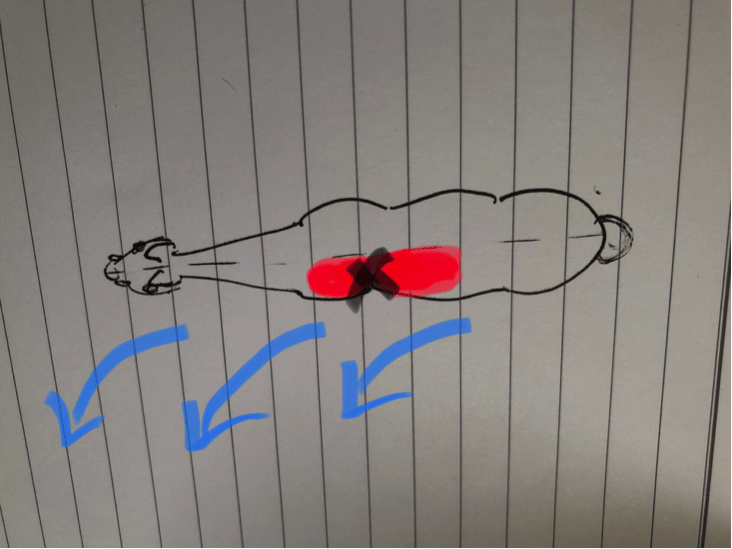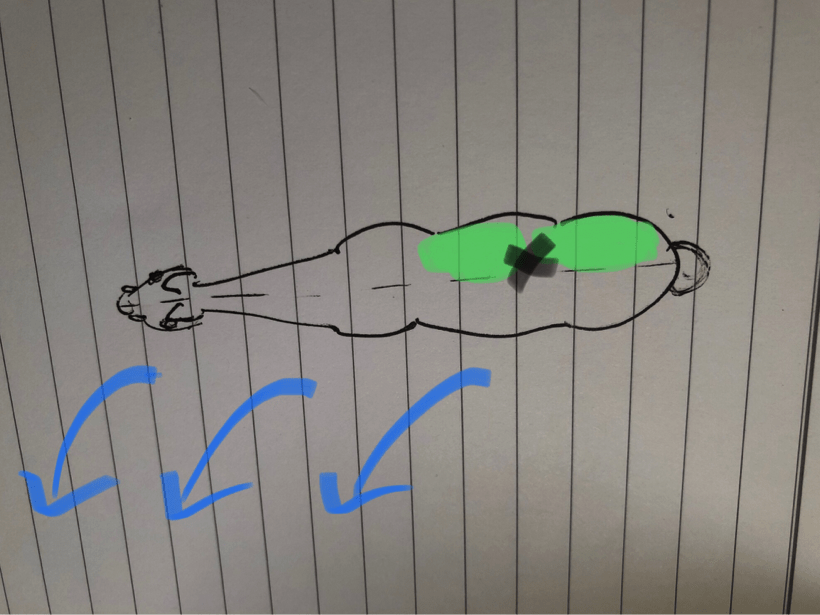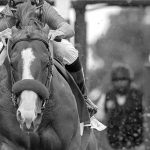Canter Aids: Driving Forward or Striking-off?
It is possible to achieve an organic canter strike off (left-lead exampled below) with either the weight to the inside OR the outside hip. To learn more about the seat aids, see my two-part article, Fundamentals: On the Seat.
The following explanation outlines what happens in each scenario:
Method A – Imbalance and Drive Forward

Our first example is through the weight to the inside hip. This is a strike off that achieves its aim through unbalancing the horse (i.e., pulling the horse or “falling” onto the desired lead), and then driving it forward until it begins to canter. Your weight aid is to the inside and the horse steps under you with their front left in their desire to stay balanced while bearing your weight primarily over their one shoulder (as in the image), which causes the horse’s center of gravity to move approximately to the black x. In this instance, with the horse and rider’s weight on the front left leg, the horse actually initiates the strike off by lifting the hind end first.
This croup-first strike off must then overcome the blocked energy of the planted, weight-bearing left front. This is however, an appropriate canter strike off that we use when we first begin to work with young horses, or horses first learning to be backed. Many horses at the lower levels have only been taught imbalancing strike offs and remain in this early stage of development throughout their working life. The problem with this is that later in training, a horse that only knows the imbalancing strike off will have difficulty learning (and sometimes a complete inability to succeed at) the flying lead change, among other things, due to this interference to forward movement caused by the block at the shoulder discussed above. You have likely heard a trainer or owner at some point talk about confirmed lead changes: something to the affect of, “we couldn’t progress any further with him as we couldn’t get a confirmed lead change out of him,” or a sale falling through on the basis of the lack of “confirmed lead change” alone, even when everyone has seen those same horses “somehow” doing fantastic lead changes on their own while they cavort around the field during their leisure hours. Sadly, these horses often get labeled as “average”, or worse! (See my article, In Defense of the Average Horse.)
Method B – Balance and Strike Off

Here, whether the horse is beginning the canter strike off from walk, trot, or halt, we assume it is already being ridden in, and understands the aids from the inside leg to outside rein and is strong enough to achieve and stay in balance through transitions.
Gathering and Balance
There is an instant where the rider changes center of gravity in conjunction with giving a slightly stronger inside leg to outside rein aid that helps alert the horse to an imminent change in activity. We are in essence, telling the horse to “please rebalance.” Astute readers will say, “ah, but this is a half halt!” We trainers spend too much time teaching the half halt as if it was a separate movement of its own and this creates difficulties in achieving accurate timing and creates an instant of rider sloppiness (delay) that opens the doorway to allow a reluctant or bored horse to balk. Rather, learn to feel what is underneath of you and in your hands. If we teach the half halt as if it is a separate movement rather than simply a natural gathering and balancing aid, we would observe that in technically difficult movements, a half halt is being performed literally, every stride! This adds a great deal of perceived complication to advanced movements that as a sum (once the horse is strong enough to execute them), should be viewed simply as the rider playing an active role in making sure s/he and the horse remain balanced in such a way that they remain as one.
But I digress. Up to this point in the article, we have established that for example B, we have balanced the horse and he is on the aids, and now anticipating the rider’s next weight and leg cue. When the horse responds appropriately to this gathering and harmonizing of energy, we can then give the weight aid to the outside hip to influence the right hind of the horse.
Request Shift in Center of Gravity
To make the transition onto the left lead, the horse has been balanced, feels the weight aid applied to the outside and adjusts his balance by stepping further under the rider with his right hind leg. This prepares his center of gravity to enable him to initiate via lifting through his shoulders, rather than lifting through the croup first. (“Initiation” being the first legs to lift off the ground after the aid.) Here, there is no blocked energy as with example A, to impede the consequent steps from strike-off.
Note that with the horse balanced, on the aids and connected in this way from hind to fore – gathered from the inside leg to outside rein – if we were to sit to the inside in this moment of connection, we could influence the horse to move its haunches in. Conversely, we see in canter departure for method A (for green horses), that without their understanding of this balancing connection from back to front, our weight aid to the inside affects only a green horse’s shoulders.
Forward Motion
We have established that it is with the above aids that we ask the horse to take a moment to rebalance itself and shift weight onto the outside hind in preparation for the transition. Now what we must add is our forward propulsion queue, which is the rider’s inside leg aid. This is the second part of our strike off request. I think we have discussed how, as we advance in training, our right leg begins to influence the right hind of the horse and the left leg begins to influence the left hind. So, for the left lead strike off, when we give the left leg aid at the girth, the horse’s right hind leg is already underneath us and we are asking for the left hind to come off the ground and push with enough force to carry’s us through the transition. Here, our “firming” right leg will sit with a slightly deeper knee, and is the counterbalance that contains the energy asked for by our inside leg aid. This prevents that propulsion force from escaping laterally to the outside, as we want that energy to flow to the fore as with the blue arrows in the images.
A Deep Knee vs Leg Behind the girth
An alternative way of speaking of the outside leg is to say that it moves behind the girth, but it is a fault to only move the lower leg behind the girth which causes the heel to shift upwards and unnaturally towards the gullet. This is a fault we see often in riders of all levels. So, it is better to learn to deepen the knee with the heel down, which slightly changes the angle of the leg from the hip down, provides supportive balance and allows the rider to retain a correct lower leg position while still shifting the leg slightly to move behind the girth. This is a lighter, quieter aid that gives some additional influence to the stirrup bar and back of the horse. It is visually pleasing, and more effective. To read more about the leg, see my two-part article, Fundamentals: on the Leg.

The Breakdown of Steps
Assuming the horse is already being ridden 1) with enough impulsion to comfortably make the transition and 2) with support from inside leg to outside rein, the very detailed steps of a correct canter strike off will be:
- Step 1: Signal to horse to prepare for a change in activity: half halt, weight to outside hip. Result: horse shifts balance slightly to outside hind leg (his croup drops) while shoulders and front legs simultaneously lift to initiate strike off.
- Step 2: Rider’s inside leg to signal the inside hind leg of the horse (which is already naturally coming off the ground) to lift more strongly and come under the horse with enough impulsion to carry the rest of the body through the transition.
- Step 3: No aid is given, but the rider is required to stay with the horse’s shifting center of gravity and not get in the way. If the horse’s balance is correct your weight will naturallyhave shifted slightly to the inside. In a nutshell, it is simply “the follow-through.”
Incidentally, when the inside hind leg of the horse comes under it during step two, this causes its back to also drops lower on the inside. Your weight will then follow that drop and fall naturally more to the inside as well. All three steps of this initiation happens within an instant though, which is why we see many riders incorrectly believe this weight-to-the-inside is part of the “initiation aid” as opposed to the natural physics of riding “as one” with a balanced horse’s motion through the second part of the strike off.
The Big Picture
So, there you have it! Because the reality is that the strike off happens in an instant it appears that we give these aids very nearly, all at once. We can however, break it down into these steps on paper or in slow motion video, to understand the reason it happens as well as gain a greater understanding of the mechanics, which aids us during practice.
Alluding back to my first note, above, another way to look at this is that the weight-aid for canter strike off is in fact a half halt, which allows the horse to shift weight just enough to “collect” energy in a way that gives it a strike off via a clear path of least resistance and greatest balance once the rider’s inside leg asks for forward propulsion to the degree the horse needs to signal a gait change.
We can recreate how this initiation-through-weight-aid feels for ourselves if we reenact the canter strike off with the one-shouldered backpack example, or holding a dumbbell only in one hand as you “canter” right or left. You would step under the weight to balance and carry it. However, to initiate forward locomotion with that weight carried in your hand or shoulder, you will find that your inclination will be to make that first step with the leg that is not bearing the weight of the backpack or dumbbell.
Advice on Retraining
A note on retraining horses that have problems with canter: I see in many riders (most often dressage), the inclination to ride with extremely strong and driving seats in an attempt to force the horse to come under itself or into lateral movements. This continual driving force becomes intolerable to most horses and they learn a false “connection” where the neck, back and belly either stiffens or drops to relieve this constant pressure. The horse becomes heavy on the fore and the croup remains up.

Unfortunately, the aphorism, “fake it till you make it,” does not apply well to horse training! Neither the rider’s hand nor leg can have any degree of accuracy in influencing the hind when the horse is not “through”. In the long term, this results in wear and tear due to weak biodynamics, along with a number of training faults that are difficult to correct.
If this is you or your horse and much of your riding is spent in a state of tension or in a frame that has no “give”, quit all lateral movements for a time and return to re-establishing the foundational requirements the horse needs to accomplish the movement or transition he is struggling with. Begin first only with developing your horse’s relaxation and rhythm through the three basic gaits (it is impossible to influence tense muscles!) As this training progresses, retain a light and correct contact with the head (a hand that follows the horse’s natural motion). Then, when we have a confident, trusting and relaxed horse that is able to begin reaching for the bit and has an open and relaxed shoulder, back and croup (its natural, forward stride), we can properly influence the topline and begin establishing correct (balancing and supportive) contact with the hands and seat. This is the doorway to being able to hold the back legs in your hands and influence the horse’s back and center of gravity through your seat. These are requirements from which a happy partnership and advancing technical proficiency are born!
Right Lead or Left Lead – Getting the Lead You Want
When we apply a canter departure through imbalance, we have the least control over accuracy. If the horse is crooked, we may very well get the wrong lead even if we are pulling mightily at the reins and driving strongly forward. When we apply a canter departure through balance and a proper strike off, we have great assurance for obtaining the correct lead as long as the rider is mindful, 1) during the balancing stage that the shoulder of the lead desired is free, and 2) when the leg is applied, that the horse receives no interference from the inside hand (and therefore blocks the inside shoulder).
A horse that is soft laterally, in both shoulders and through the back, will willingly give his rider either the right or left lead if requested, and regardless of its direction in the school. If the horse is soft only on one side, it will pick up the lead on its stiff side. So, know your horse and prepare him to succeed at the strike off. If you cannot get the correct lead, or you are only able to achieve it on your first request…some of the time, work on softening the horse’s shoulder and back and improving the connection in your hand at walk and trot before working on correcting your horse’s canter departure again.
There is nothing more miserable (mentally) for a horse than to be driven to obedience through endless and mind numbing repetitions of an exercise until they “get it right.” (See my article on Obedience vs Partnership.) Furthermore, stubbornly forcing an exercise the horse repeatedly fails at creates a horse that is either sour or if the forgiving sort, so dull on the aids that he will only be able to pick up the correct lead for you (with any accuracy) in the school where he has walls to judge which lead is the “right one”. Teaching a horse to pick up the “right” lead based off of which direction he is going in the school can be beneficial for lesson horses that are teaching raw beginners but has no place in horses being taught more advanced lessons in the art. Neither your emotional anger or the wear and tear to the horse’s joints is worth the punishment of endless repetition when it is not the canter departure that is the problem, but a physical discomfort or a deficiency in a foundational pre-requisite that the horse has not yet established.
Conclusion
So, we now know that there are two different ways to ask for canter. One is not better than the other, but rather, which method you use, should depend on the horse’s (or rider’s) level of training with the expectation that as the horse strengthens, balances and learns more about becoming a fine riding horse, it will be able to easily achieve a canter strike off prepared by the hind stepping under and allowing the shoulder to lift. If we approach training thoughtfully in this manner, your strike off and mutual accuracy will happen very easily as an outcome of the foundation we set during the horse’s earlier program.
Euki is the founder of Adaptive Development EQ and currently coaching and consulting in Denver, Colorado. She loves helping people get inspired about the developmental process of holistic/whole-horse training, and is on a mission to help riders and owners rediscover their horses, and fall in love with them all over again.






